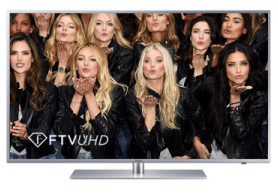
After more than 40 years of operation, DTVE is closing its doors and our website will no longer be updated daily. Thank you for all of your support.
Sharp practices – future development of HD technologies
With HDTV now increasingly seen as standard, what’s next for broadcasters and service providers? Stuart Thomson assesses the prospects for higher resolution formats and the new compression technologies that could facilitate them.
High-definition TV has now been a standard feature of almost all pay TV platforms for so long that technology issues relating to it have all but ceased to be newsworthy. Advances in compression continue to be made, of course, but with H.264 now a universally accepted standard, and mass penetration of H.264 equipment in numerous markets worldwide an established fact, it is moot whether there is pressure from the market for a significant new technological advance or step change that would make the delivery of HD more efficient.
Of course, there is always interest on the part of broadcasters and service providers in finding ways to reduce bandwidth – but within the parameters set by H.264. There is little appetite for another compression technology that would render existing equipment obsolete, and no compelling bandwidth-hungry new application that would force broadcasters and service providers to think again.
On the last point, there has of course been discussion of late of 1080p50/60 HD (or so-called full HD) as well as 2K, 4K and even 8K or UHDTV (2K, 4K and 8K refer to the number of horizontal pixels in a frame rather than the vertical resolution, as is the case, for example, with 1080p), but whether any of these formats will find a market soon is open to question. Most HD video to the home today is delivered in 1080i or 720p, and those formats seem to meet the needs of broadcasters and consumers alike. While content producers are interested to some extent in creating content in the 1080p format and then down-converting it for distribution, even in the relatively narrow context of the content creation business the need to replace storage systems and editing suites means that moves in this direction will involve significant investment.
Full HD
On the distribution network and consumer side, adoption of advanced HD formats certainly seems a long way off, at least in Europe.
“We don’t see a lot of requests for 1080p,” says Ronan Lhostis, product manager at technology provider Thomson Video Networks. He argues that the difference in user experience compared with the existing 720p or 1080i formats is negligible when the size of flatscreen TVs commonly found in people’s homes – as well as the bandwidth constraints faced by distributors – is taken into account. “It will take a lot of bandwidth and the difference is not so great,” he says. It is possible that ISPs with very high-bandwidth networks, such as FTTH providers, could see 4K or 8K as something that could be marketed to a relatively small number of very high-end subscribers. However, for mass-market consumption, even with relatively high-speed networks, the cost of delivering content is likely to outweigh any incremental revenue benefit.
For mass-market distributors such as cable, satellite and terrestrial broadcasters, in any case, interest remains very low. HD now accounts for a relatively high proportion of service providers’ channel line-ups – particularly in the US – and broadcasters have yet to deliver full HD let alone UHDTV. “Even today when you look at HD versus SD it’s difficult to see the difference between them sometimes,” says Lhostis. “If you do UHDTV with a bitrate that’s not sufficient you will not see the difference between that and [regular] HD.”
Right now a lot of content is made in 1080p24 because people want to simulate the look of film.
Don Jarvis, A+E Network
The view that TV of a higher resolution than is currently available is unlikely to be something that large numbers of consumers will demand soon is one that is supported by Don Jarvis, vice-president of engineering at content provider A+E Networks. While content providers including A+E Networks are supporting higher-resolution formats within their own production environments, this is mostly due to specific factors including producers’ interest in 4K cameras and the flexibility they provide in the editing process. “Right now a lot of content is made in 1080p24 because people want to simulate the look of film,” says Jarvis. A+E Networks, he says, now commonly receives content from production companies in 4K resolution but this needs to be rate-reduced for onward distribution. In terms of distribution, he says, A+E Networks may deliver some content in resolutions up to 2K, but only for promotional purposes – for example display on cinema screens.
More bullish on the prospects for 1080p50/60 is JC Morizur, vice-president of product marketing at video compression specialist Harmonic. In contrast to the disappointing reception given to 3D TV, says Morizur, interest in full HD is significant – at least in the US. “There is high interest in 1080p50/60,” he says. “When it comes to the consumer experience, 1080p50/60 is definitely more appealing and less disruptive to deploy than full frame-rate 3D.”
Morizur agrees with Thomson’s Lhostis that development of high-resolution formats could be driven by over-the-top providers targeting games consoles, iPads and other devices that can playback video up to 1080p60. However, he believes that pay TV operators will be quick to follow, delivering 1080p services to differentiate themselves from the OTT competition and provide something new to US subscribers for whom HD is essentially a basic requirement. Consumers will compare their existing HD pay TV services with the superior experience offered by Blu-ray and on-demand services from OTT players and realize they want something more. “I think there will be an opportunity for our tier one customers…to launch new high-end services because TVs are capable of 1080p60 and it’s the next step for the consumer experience beyond what they get today even from Blu-ray,” he says.
Bandwidth crunch
[icitspot id=”16303″ template=”box-story”]If more and better HD is indeed on the way, will this not lead to a bandwidth crunch? To the extent that lack of available bandwidth is a problem, there are innovations in the pipeline that could help solve it. The most significant one is probably High-Efficiency Video Coding (HEVC), a new compression standard that promises up to a 40% saving on bitrate for HD compared with H.264. The first committee draft for HEVC is scheduled to be complete in February 2012, with a draft standard possible by July that year.
For Thomson’s Lhostis, factors likely to limit interest in HEVC include the fact that it is “totally different from H.264”, therefore requiring a step-change for content providers, broadcasters and service providers. Currently, he says, HEVC is a ‘progressive-only’ technology, incompatible with interlaced displays. For this and other reasons, he suggests, it may make more sense to look to what can still be achieved with H.264, where he sees the possibility of a further 30% saving, closing the advantage promised by the new technology.
Harmonic’s Morizur, though enthusiastic about the prospects for take-up of 1080p, believes that rollouts will continue to be H.264-based. Service providers will not be interested in deploying a new technology that would require significant new investment in expensive set-tops. Morizur says that chipset vendors are able and ready to support 1080p or even 2K/4K based on H.264. This is despite the fact that he is less optimistic about the ability to H.264 to close the gap before diminishing returns set in on investment in new compression platforms. Most advances, he says, will come from advances in things such as the rate control algorithm, the motion algorithm or in pre-processing techniques.
“As you go forward the industry can target an improvement on best-of-breed solutions today of 10% give or take,” he says. However, Morizur argues that advances in compression will not be a major factor in whether service providers roll out full HD. It is likely, he says, that they will only launch a handful of channels targeted at very high-end subscribers and the impact on overall bandwidth will be relatively small. Bandwidth will also be freed up over time, he says, by service providers running down their SD tiers (“now the equivalent of analogue for cable”). For cable operators with DOCSIS 3.0-capable networks, and for DTH players, bandwidth will be less of an issue than for telcos and for OTT services. However, the latter are likely to kick off by launching non-linear on-demand services and to provide services selectively to those home that are capable of receiving them.
[icitspot id=”16313″ template=”box-story”]Carl Furgusson, vice-president of product management, compression at Ericsson, on the other hand, believes that HEVC is likely to have more appeal in the point-to-point content creation and acquisition environment than for the consumer side. (Nevertheless, he points out that in many cases people are still using MPEG-2 links for content acquisition and have yet to migrate to MPEG-4 4:2:2 10-bit resolution.) Backhaul, digital cinema and – potentially – next-generation consumer handheld devices and PCs are three possible areas of application for HEVC in Furgusson’s view. Delivery of video to this type of device does not require the new codec to be set in silicon. The potential bandwidth savings could, in his view, be substantial, particularly for the 4K TV. “A combination of 1080p60 and 3D content acquisition from live events means HEVC in the future could become very interesting, especially if you are using satellite rather than fibre links,” says Furgusson.
HEVC adds a number of tools to the compression armoury through the sophisticated use of Context-Adaptive Binary Arithmetic Encoding (CABAC), a technique that is already part of the H.264 standard. “HEVC is an evolution of H.264 with many more options,” he says. While it will take more processing power than H.264, he points out that once the standard is ratified DSPs will rapidly become available that are two to three times more powerful than those available today.
Nevertheless, Furgusson agrees with Lhostis that H.264 “is not finished yet”. As FPGAs and chipsets with greater processing power become available at a price point that makes sense, improvements in compression continue to be made, while further innovations continue to be seen in proprietary pre-processing techniques that can be applied before (standards-based) compression is performed. “We continue to invest and improve in what we can do with H.264 which is widely deployed and is the main codec for HD,” says Furgusson. “It’s also the common codec in most multi-screen formats today.”
The key factor that made H.264 so successful was the coincidental rollout of HD to the home and the deployment of TV over ADSL networks – both of which applications were extremely bandwidth-hungry. By comparison, HEVC remains a technology in search of compelling application that could drive uptake. “HEVC has the aim to be at least 50% more efficient than H.264, but at the same time it needs to be commercially viable and needs some applications for mass adoption in the marketplace,” says Furgusson. Possible drivers could include delivering HD video to the next generation of handheld devices or the future migration of service providers to a new codec in markets where MPEG-2 is still dominant, such as the US (where the ATSC is currently considering requirements for a next-generation digital TV standard). There is, says Furgusson, some discussion with the group looking at HEVC to include interlacing tools as part of the standard and it is also possible that progressive-to-interlaced display adaptation could be provided within the output adapter in the receiving device that creates HDMI or composite video for the display.
For a content provider such as A+E Networks, the primary focus is H.264. “We are just now in strategic planning for a migration to end MPEG-2 transmission at some point,” says Jarvis. While advanced codecs maybe of interest further down the line, any change would have to be backwards compatible with existing reception equipment.
Harmonic’s Morizur, meanwhile, believes there may be considerable interest in Scalable Video Coding (SVC) in the future to enable the bandwidth-efficient delivery of 1080p50/60 and legacy HD formats. This is an annex of H.264, originally designed to support multiple resolution video over cellular and OTT networks (but largely superseded by the development of adaptive bit-rate streaming), that provides a standard for the encoding of a video stream that also contains subset bitstreams, for which room is made by dropping packets for the larger video stream. This, he says, could be used to deliver multiple HD formats more efficiently, serving both high-end 1080 subscribers and those happy with their 1080i or 720p services. “When service providers start rolling out more 1080p channels they will want to be compliant with non-1080p-capable set-tops,” says Morizur. “[However], the complexity of SVC wouldn’t warrant it for five to six channels only – in that case you would multicast with independent streams – so it depends on the future adoption of 1080p.” It is likely that the range of resolutions delivered to consumers is only going to grow larger, and technologists are likely to focus their attention on how to deliver multiple variants as efficiently as possible.



